Effects of the γ″-Ni3Nb Phase on Fatigue Behavior of Nickel-Based 718 Superalloys with Different Heat Treatments
Abstract
:1. Introduction
2. Experimental Procedures
2.1. Samples Preparation
2.2. Characterization
2.3. Fatigue Experiments
3. Results and Discussion
3.1. Microstructure
3.2. HCF Performance
3.3. LCF Performance
3.4. Fatigue Fracture Analysis
4. Conclusions
- Under the treatments of the SHT, HIP + STA and HIP + DA, the volume fraction of γ″ phases in the samples increased from 18.5% (SHT) to 26.4% (HIP + STA) and 24.3% (HIP + DA). However, many relatively coarse γ″ phases with major axes of ~80 nm and minor axes of ~40 nm were only observed in the grain boundaries of the HIP + DA sample.
- With a stress amplitude of 380 MPa, the HIP + DA sample showed the longest HCF life of 5.16 × 105 cycles. Additionally, the HIP + DA sample showed the longest LCF life of 1.70 × 104 cycles, which was higher than the SHT and HIP+ STA samples.
- Laves phases and carbide inclusions near the surface of the samples were the sources of fatigue fracture. Additionally, the acicular δ phases were the carriers for fatigue crack propagation.
- The γ″ phases with high content in the matrix and relatively coarse γ″ phases in the grain boundaries of the samples can hinder dislocation movement, which has a great influence on the fatigue life improvement.
Author Contributions
Funding
Conflicts of Interest
References
- Pollock, T.M.; Tin, S. Nickel-Based Superalloys for Advanced Turbine Engines: Chemistry, Microstructure and Properties. J. Propul. Power 2006, 22, 361–374. [Google Scholar] [CrossRef]
- Lin, Y.C.; Min, H.E.; Chen, M.S.; Wen, D.X.; Chen, J. Effects of initial δ phase (Ni3Nb) on hot tensile deformation behaviors and material constants of Ni-based superalloy. Trans. Nonferrous Met. Soc. China 2016, 26, 107–117. [Google Scholar] [CrossRef]
- Zhang, P.; Hu, C.; Ding, C.G.; Zhu, Q.; Qin, H.Y. Plastic deformation behavior and processing maps of a Ni-based superalloy. Mater. Des. 2015, 65, 575–584. [Google Scholar] [CrossRef]
- Long, Y.T.; Nie, P.L.; Li, Z.G.; Huang, J.; Li, X.; Xu, X.M. Segregation of niobium in laser cladding Inconel 718 superalloy. Trans. Nonferrous Met. Soc. China 2016, 26, 431–436. [Google Scholar] [CrossRef]
- Shi, Z.X.; Yan, X.F.; Duan, C.H.; Zhao, M.H. Effect of strain rate on hot deformation characteristics of GH690 superalloy. Trans. Nonferrous Met. Soc. China 2017, 27, 538–550. [Google Scholar] [CrossRef]
- Lin, Y.C.; Deng, J.; Jiang, Y.Q.; Wen, D.X.; Liu, G. Hot tensile deformation behaviors and fracture characteristics of a typical Ni-based superalloy. Mater. Des. 2014, 55, 949–957. [Google Scholar] [CrossRef]
- Radavich, J.F. The physical metallurgy of cast and wrought alloy 718. In Proceedings of the International Symposium on Superalloys, Champion, PA, USA, 19–23 September 2004. [Google Scholar]
- Peng, Z.; Qiang, Z.; Chao, H.; Wang, C.J.; Gang, C.; Qin, H.Y. Cyclic deformation behavior of a nickel-base superalloy under fatigue loading. Mater. Des. 2015, 69, 12–21. [Google Scholar]
- Naghipour, P. 15-Predicting the fatigue life ofadhesively-bonded composite joints under mixed-mode fractureconditions. In Fatigue and Fracture of Adhesively-Bonded Composite Joints; Woodhead Publishing: Cambridge, UK, 2015; pp. 419–441. [Google Scholar]
- Hua, Y.; Liu, Z.Q.; Wang, B.; Hou, X. Surface modification through combination of finish turning with low plasticity burnishing and its effect on fatigue performance for Inconel 718. Surf. Coat. Technol. 2019, 375, 508–517. [Google Scholar] [CrossRef]
- He, D.G.; Lin, Y.C.; Wang, L.H.; Wu, Q.; Zu, Z.H.; Cheng, H. Influences of pre-precipitated δ phase on microstructures and hot compressive deformation features of a nickel-based superalloy. Vacuum 2019, 161, 242–250. [Google Scholar] [CrossRef]
- Gribbin, S.; Ghorbanpour, S.; Ferreri, N.C.; Bicknell, J.; Tsukrov, I.; Knezevic, M. Role of grain structure, grain boundaries, crystallographic texture, precipitates, and porosity on fatigue behavior of Inconel 718 at room and elevated temperatures. Mater. Charact. 2019, 149, 184–197. [Google Scholar] [CrossRef]
- Sui, S.; Chen, J.; Fan, E.; Yang, H.; Lin, X.; Huang, W. The influence of Laves phases on the high-cycle fatigue behavior of laser additive manufactured Inconel 718. Mater. Sci. Eng. A 2017, 695, 6–13. [Google Scholar] [CrossRef]
- Zhang, P.; Zhu, Q.; Chen, G.; Qin, H.; Wang, C. Effect of Heat Treatment Process on Microstructure and Fatigue Behavior of a Nickel-Base Superalloy. Materials 2015, 8, 6179–6194. [Google Scholar] [CrossRef] [PubMed]
- Qin, C.H.; Zhang, X.C.; Ye, S.; Tu, S.T. Grain size effect on multi-scale fatigue crack growth mechanism of Nickel-based alloy GH4169. Eng. Fract. Mech. 2015, 142, 140–153. [Google Scholar] [CrossRef]
- Gribbin, S.; Bicknell, J.; Jorgensen, L.; Tsukrov, I.; Knezevic, M. Low cycle fatigue behavior of direct metal laser sintered Inconel alloy 718. Int. J. Fatigue 2016, 93, 156–167. [Google Scholar] [CrossRef]
- Zhang, X.C.; Li, H.C.; Zeng, X.; Tu, S.T.; Zhang, C.C.; Wang, Q.Q. Fatigue behavior and bilinear Coffin-Manson plots of Ni-based GH4169 alloy with different volume fractions of δ phase. Mater. Sci. Eng. A 2017, 682, 12–22. [Google Scholar] [CrossRef]
- He, Z.; Zhang, Y.; Qiu, W.; Shi, H.J.; Gu, J. Temperature effect on the low cycle fatigue behavior of a directionally solidified nickel-base superalloy. Mater. Sci. Eng. A 2016, 676, 246–252. [Google Scholar] [CrossRef]
- Qin, H.; Bi, Z.; Yu, H.; Feng, G.; Du, J.; Zhang, J. Influence of stress on γ″ precipitation behavior in Inconel 718 during aging. J. Alloys Compd. 2018, 740, 997–1006. [Google Scholar] [CrossRef]
- Yu, Z.; Rao, S.X.; Zheng, Z.; Zhao, Z.H. Interaction of hot isostatic pressing temperature and hydrostatic pressure on the healing of creep cavities in a nickel-based superalloy. Mater. Des. 2013, 49, 25–27. [Google Scholar]
- Broeckmann, C. Hot isostatic pressing of near net shape components–process fundamentals and future challenges. Powder Metall. 2012, 55, 176–179. [Google Scholar] [CrossRef]
- Farahany, S.; Aghaie-Khafri, M.; Ourdjini, A.; Idris, M.H. Influence of Heat Treatment on Properties of Hot Isostatically Pressed Turbine Blade Superalloy IN738. Adv. Mater. Res. 2011, 264, 502–507. [Google Scholar] [CrossRef]
- Qiu, C.L.; Attallah, M.M.; Wu, X.H.; Andrews, P. Influence of hot isostatic pressing temperature on microstructure and tensile properties of a nickel-based superalloy powder. Mater. Sci. Eng. A 2013, 564, 176–185. [Google Scholar] [CrossRef]
- Chang, L.; Sun, W.; Cui, Y.; Zhang, F.; Yang, R. Effect of heat treatment on microstructure and mechanical properties of the hot-isostatic-pressed Inconel 718 powder compact. J. Alloys Compd. 2014, 590, 227–232. [Google Scholar] [CrossRef]
- Liu, Y.H.; Kang, M.D.; Wu, Y.; Wang, M.M.; Li, M.; Yu, J.W.; Gao, H.Y.; Wang, J. Crack formation and microstructure-sensitive propagation in low cycle fatigue of a polycrystalline nickel-based superalloy with different heat treatments. Int. J. Fatigue 2018, 108, 79–89. [Google Scholar] [CrossRef]
- Liu, Y.H.; Kang, M.D.; Wu, Y.; Wang, M.M.; Gao, H.Y.; Wang, J. Effects of microporosity and precipitates on the cracking behavior in polycrystalline superalloy Inconel 718. Mater. Charact. 2017, 132, 175–186. [Google Scholar] [CrossRef]
- Prasad, K.; Sarkar, R.; Ghosal, P.; Kumar, V. Simultaneous creep–fatigue damage accumulation of forged turbine disc of IN 718 superalloy. Mater. Sci. Eng. A 2013, 572, 1–7. [Google Scholar] [CrossRef]
- Mahobia, G.S.; Paulose, N.; Mannan, S.L.; Sudhakar, R.G.; Chattopadhyay, K.; Srinivas, N.C.S.; Singh, V. Effect of hot corrosion on low cycle fatigue behavior of superalloy IN718. Int. J. Fatigue 2014, 59, 272–281. [Google Scholar] [CrossRef]
- Liu, Y.H.; Wu, Y.; Kang, M.D.; Wang, M.M.; Li, M.; Gao, H.Y.; Wang, J.; Sun, B.D.; Ning, Y. Fracture mechanisms induced by microporosity and precipitates in isothermal fatigue of polycrystalline nickel based superalloy. Mater. Sci. Eng. A 2018, 736, 438–452. [Google Scholar] [CrossRef]
- Aboulkhair, N.T.; Maskery, I.; Tuck, C.; Ashcroft, I.; Everitt, N.M. Improving the fatigue behaviour of a selectively laser melted aluminium alloy: Influence of heat treatment and surface quality. Mater. Des. 2016, 104, 174–182. [Google Scholar] [CrossRef]

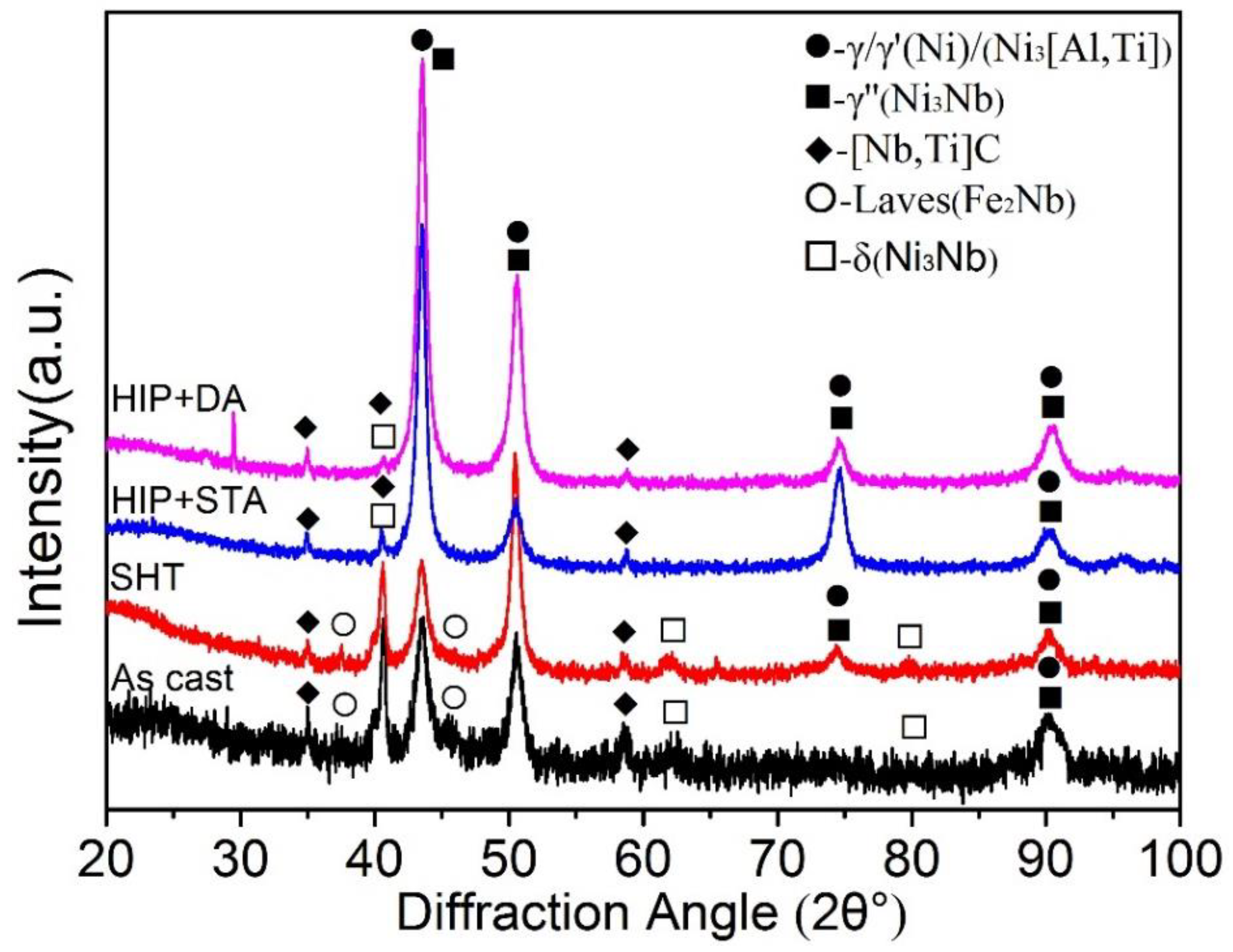
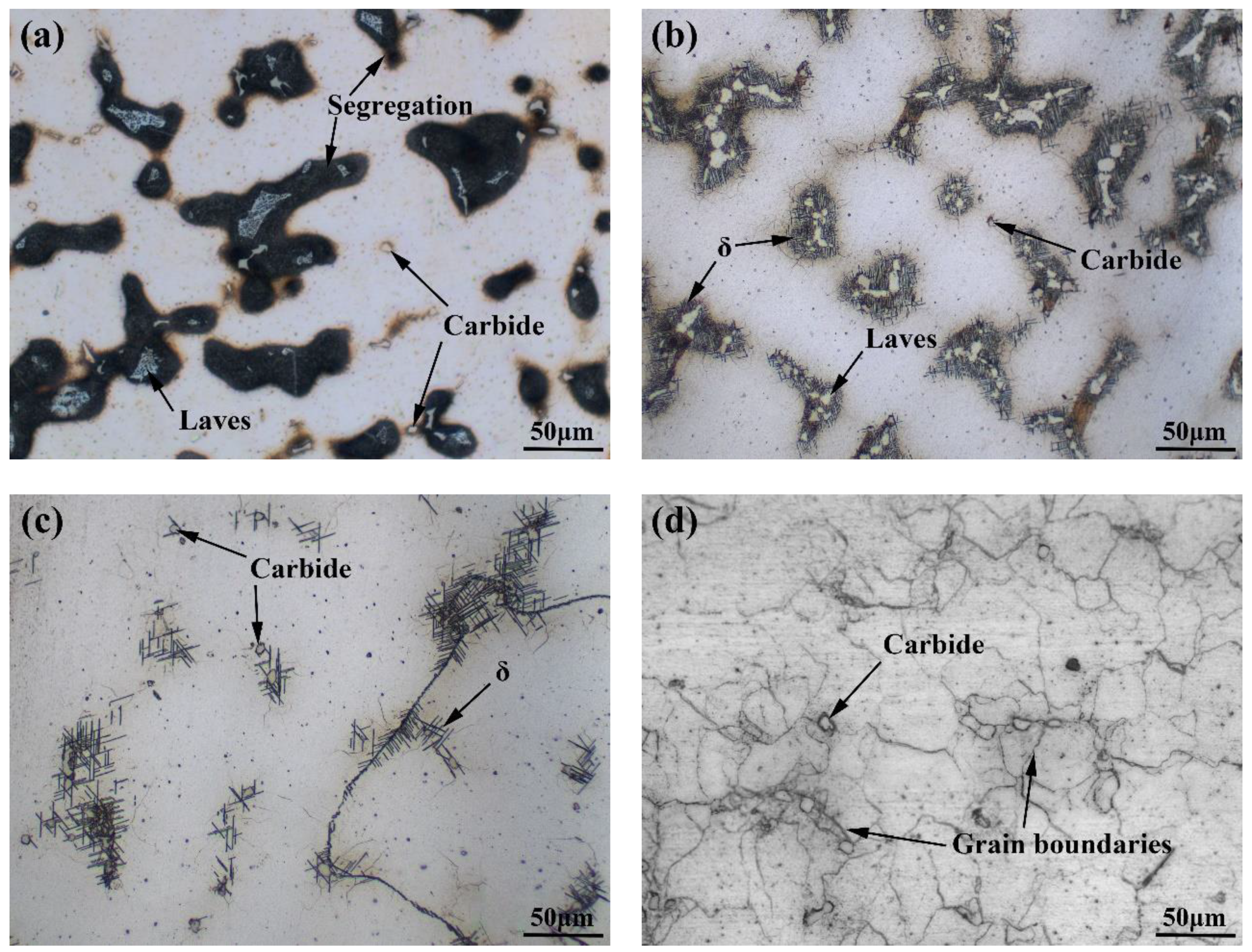
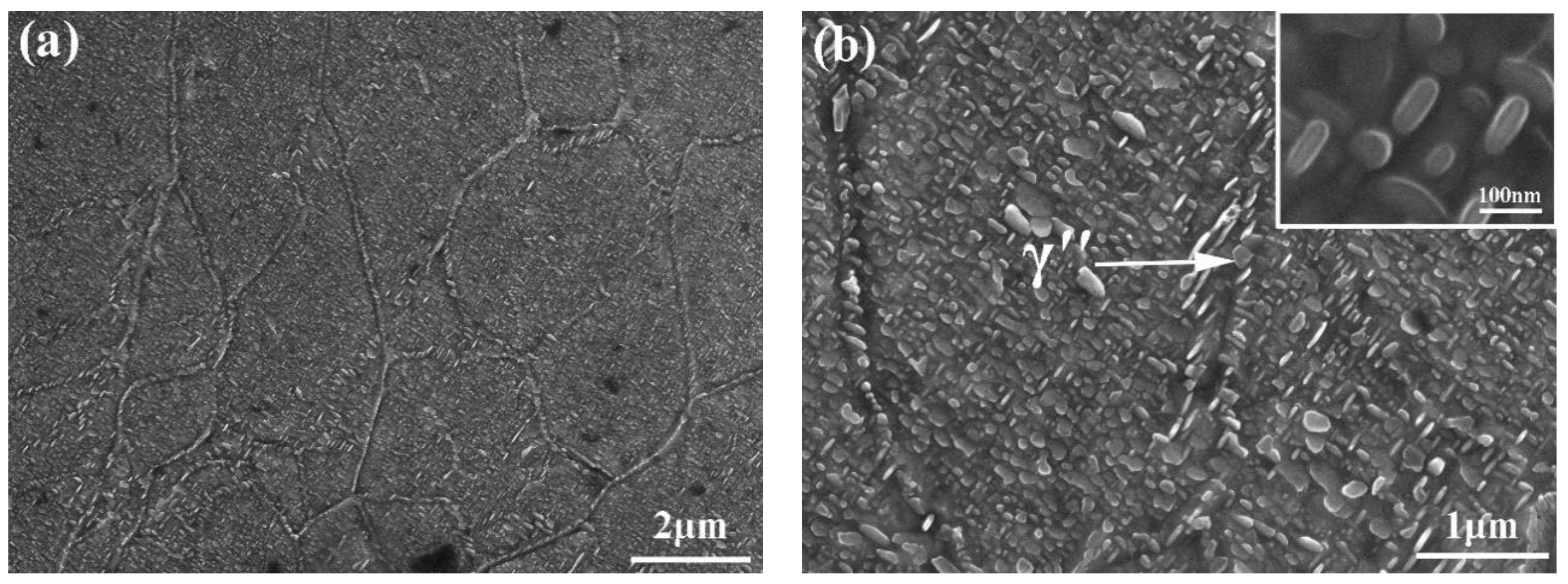

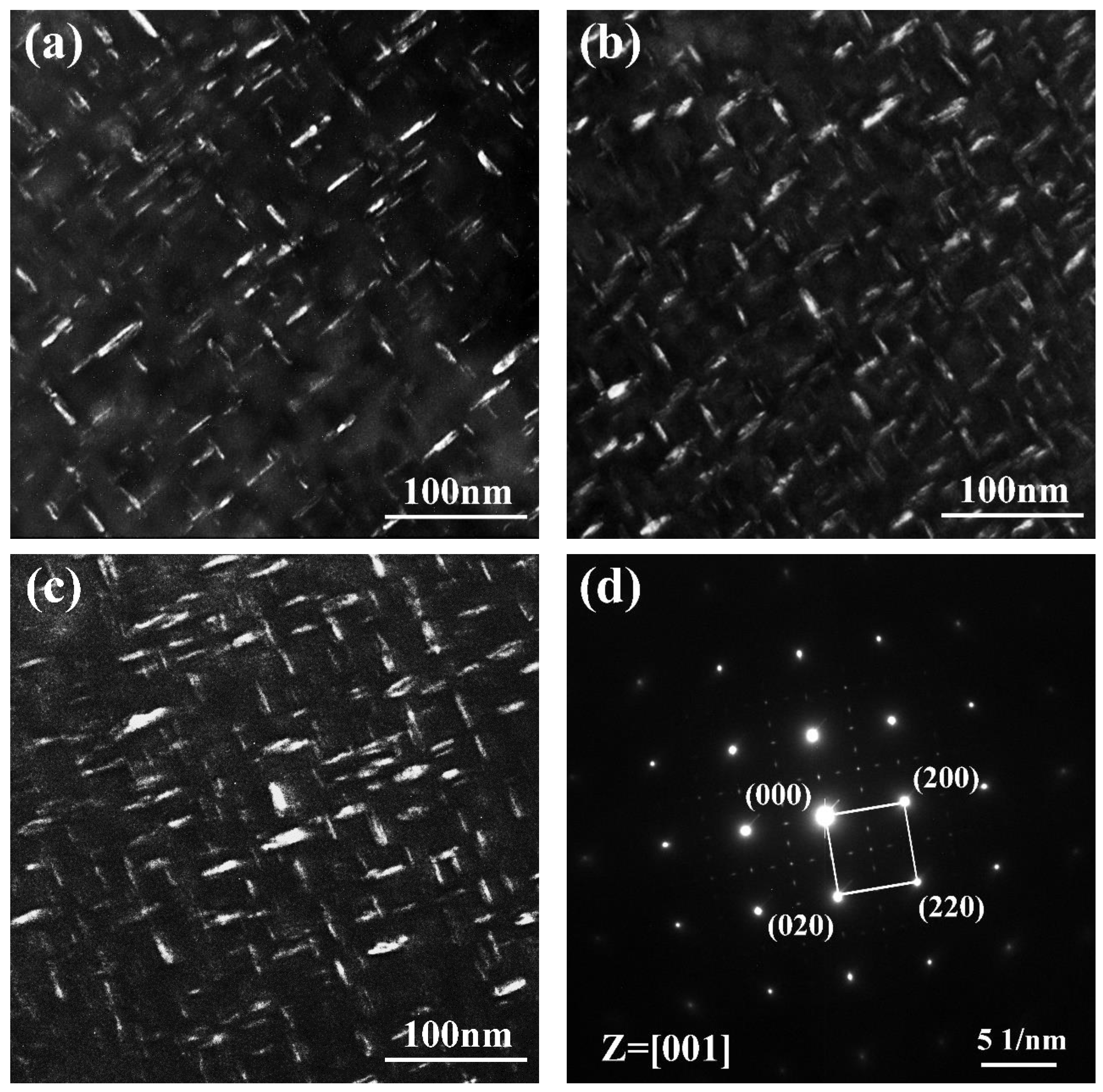
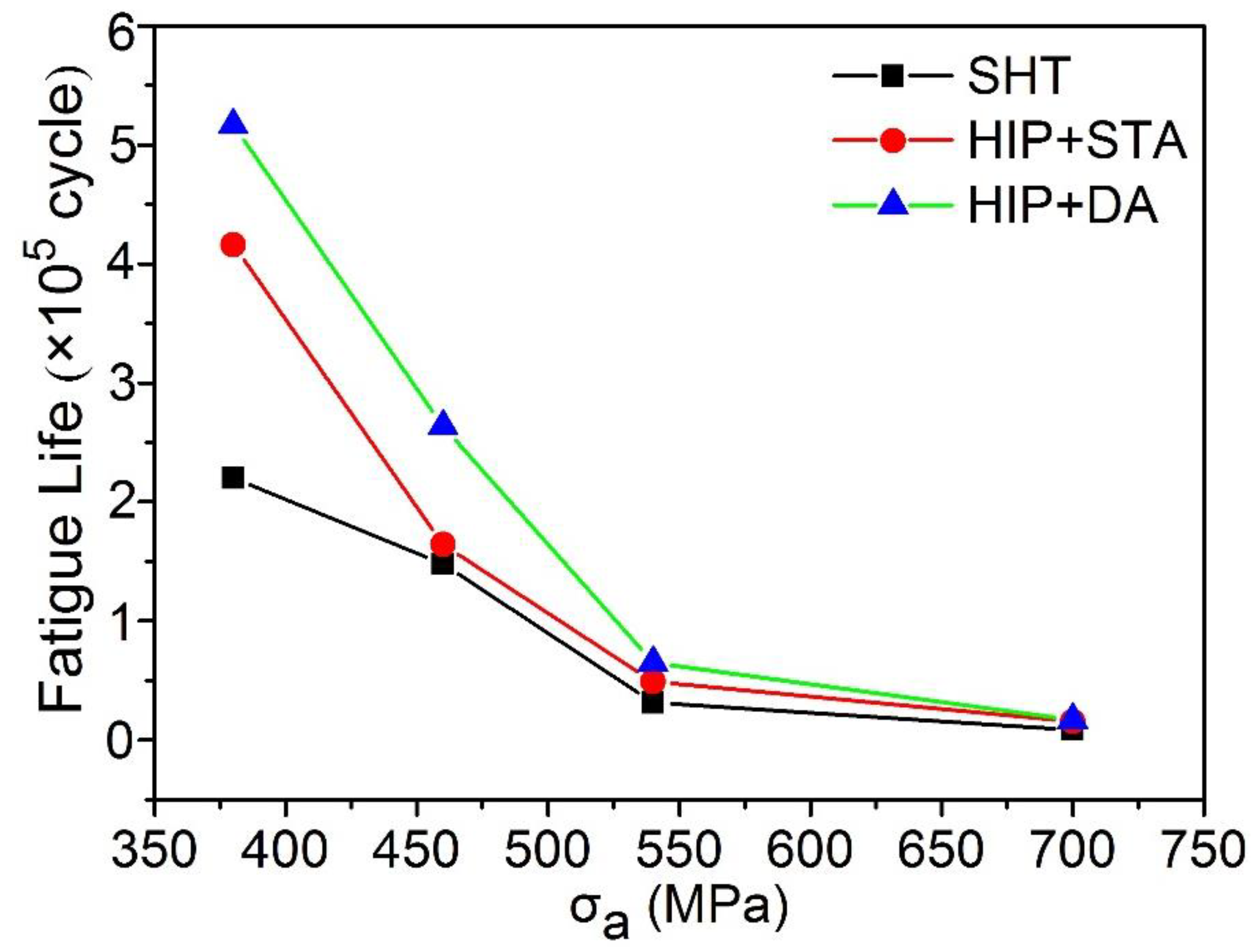
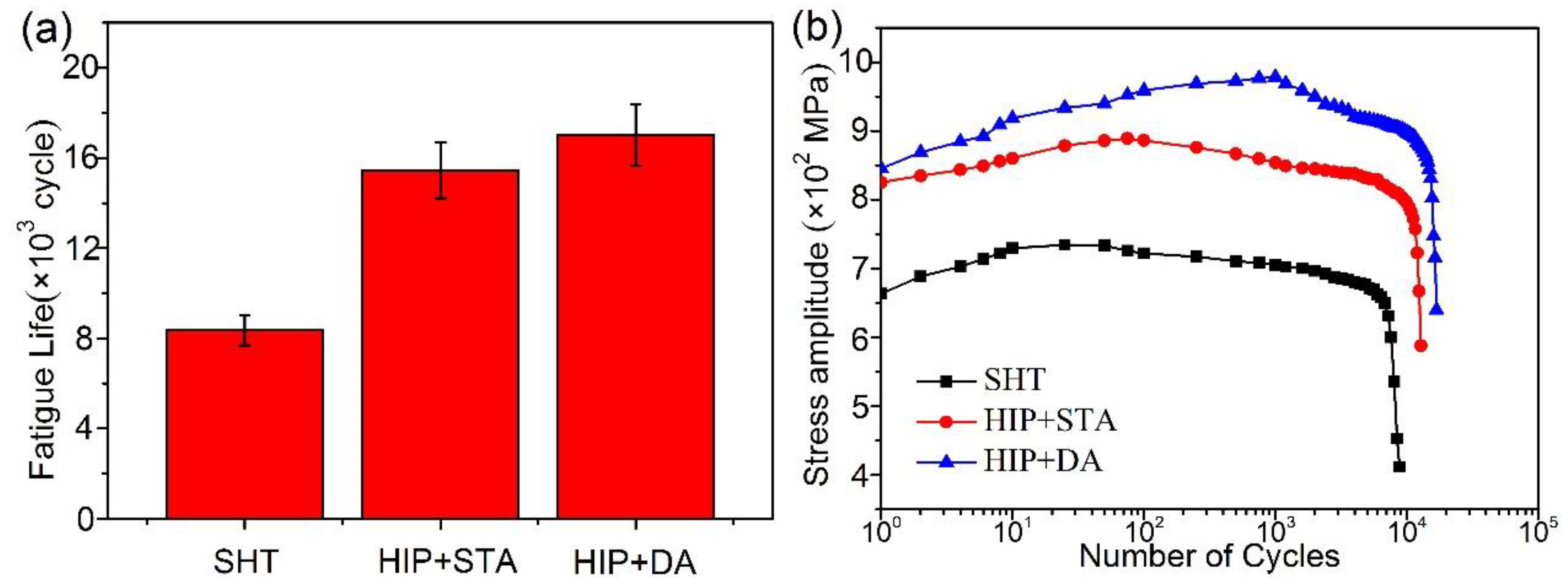



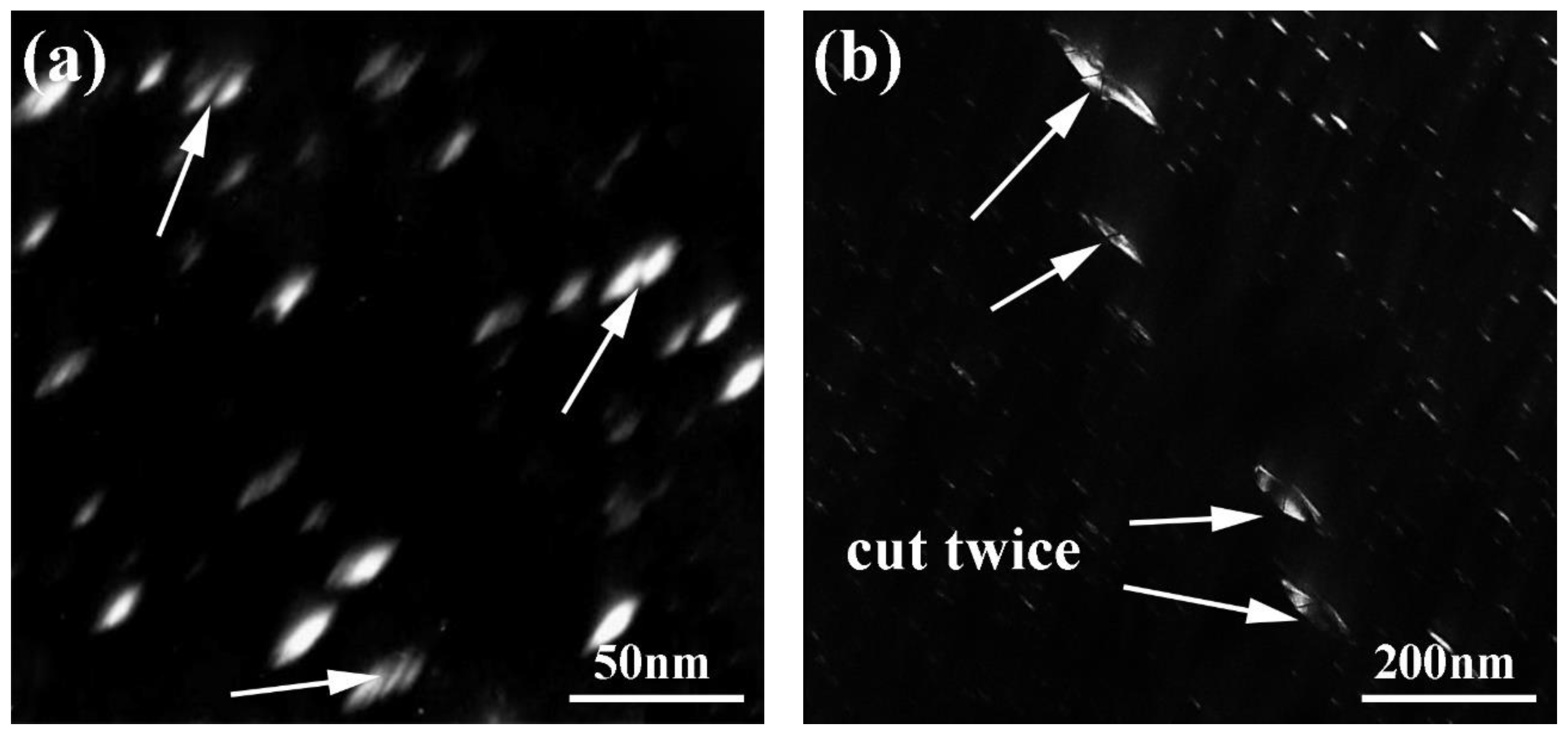
| C | Cr | Ni | Co | Mo | Al | Ti | Nb | Fe |
|---|---|---|---|---|---|---|---|---|
| 0.06 | 19.43 | 52.90 | 0.18 | 3.15 | 0.41 | 1.06 | 4.36 | Bal |
| Designation | Hot Isostatic Pressing | Homogenization | Solution | Aging |
|---|---|---|---|---|
| As-cast | None | None | None | None |
| SHT | None | 1095 °C/1 h/AC | 950 °C/1 h/AC | 720 °C/8 h/FC at 55 °C/h 620 °C/8 h/AC |
| HIP+STA | 1170 °C/140 MPa/4 h/FC | None | 950°C/1h/AC | 720 °C/8 h/FC at 55 °C/h 620 °C/8 h/AC |
| HIP+DA | 1170 °C/140 MPa/4 h/FC | None | None | 720 °C/8h/FC at 55°C/h 620 °C 8 h/AC |
- SHT: standard heat treatment
- HIP + STA: hot isostatic pressing + solution treatment + aging
- HIP + DA: hot isostatic pressing + direct aging
| Samples | SHT | HIP + STA | HIP + DA |
|---|---|---|---|
| Mean major axes (nm) | 22.6 ± 4.1 | 23.1 ± 3.7 | 27.8 ± 3.8 |
| Mean minor axes (nm) | 8.1 ± 0.8 | 8.4 ± 1.0 | 8.8 ± 0.8 |
| Volume fraction (%) | 18.5 ± 0.2 | 26.4 ± 0.3 | 24.3 ± 0.1 |
- SHT: standard heat treatment
- HIP + STA: hot isostatic pressing + solution treatment + aging
- HIP + DA: hot isostatic pressing + direct aging
© 2019 by the authors. Licensee MDPI, Basel, Switzerland. This article is an open access article distributed under the terms and conditions of the Creative Commons Attribution (CC BY) license (http://creativecommons.org/licenses/by/4.0/).
Share and Cite
Ling, L.-S.-B.; Yin, Z.; Hu, Z.; Wang, J.; Sun, B.-D. Effects of the γ″-Ni3Nb Phase on Fatigue Behavior of Nickel-Based 718 Superalloys with Different Heat Treatments. Materials 2019, 12, 3979. https://doi.org/10.3390/ma12233979
Ling L-S-B, Yin Z, Hu Z, Wang J, Sun B-D. Effects of the γ″-Ni3Nb Phase on Fatigue Behavior of Nickel-Based 718 Superalloys with Different Heat Treatments. Materials. 2019; 12(23):3979. https://doi.org/10.3390/ma12233979
Chicago/Turabian StyleLing, Li-Shi-Bao, Zheng Yin, Zhi Hu, Jun Wang, and Bao-De Sun. 2019. "Effects of the γ″-Ni3Nb Phase on Fatigue Behavior of Nickel-Based 718 Superalloys with Different Heat Treatments" Materials 12, no. 23: 3979. https://doi.org/10.3390/ma12233979
APA StyleLing, L.-S.-B., Yin, Z., Hu, Z., Wang, J., & Sun, B.-D. (2019). Effects of the γ″-Ni3Nb Phase on Fatigue Behavior of Nickel-Based 718 Superalloys with Different Heat Treatments. Materials, 12(23), 3979. https://doi.org/10.3390/ma12233979





